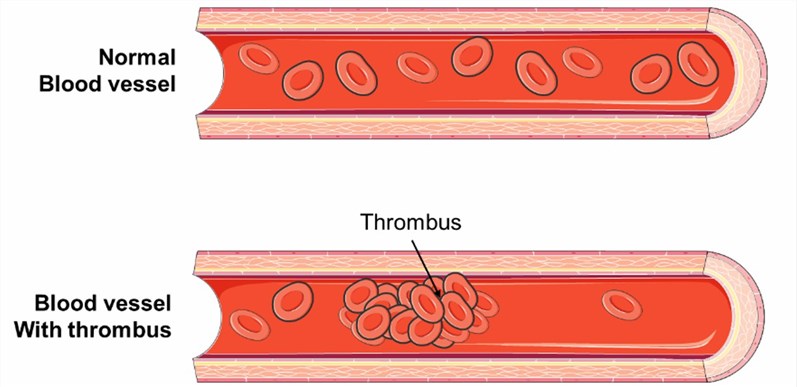Thrombophilia
Thrombophilia is a condition that makes the blood more prone to clotting, leading to an increased risk of thrombosis, which can result in serious complications, such as pulmonary embolism, stroke, and pregnancy loss. Thrombophilia can be inherited or acquired, depending on genetic or environmental factors affecting the coagulation system. It poses a significant public health concern, impacting approximately 5% to 8% of the general population and causing significant morbidity and mortality. The diagnosis and treatment of thrombophilia are challenging and complex, involving various methods and techniques such as blood tests, imaging studies, genetic tests, and risk assessment tools. Treatment options include anticoagulants, antiplatelet agents, thrombolytics, compression therapy, surgery, and lifestyle modifications. However, clear guidelines or consensus on when and how to test and treat thrombophilia in different clinical scenarios are lacking. One emerging area in thrombophilia research is the association between chromosomal abnormalities and thrombotic risk. Chromosomal abnormalities are changes in the structure or number of chromosomes that can affect the expression or function of genes involved in the coagulation cascade or anticoagulant pathways. Examples of chromosomal abnormalities include Down syndrome, Turner syndrome, Klinefelter syndrome, and others.
Clinical Manifestations
Thrombophilia predisposes individuals to increased clotting, leading to a higher risk of thrombosis and severe complications. The primary manifestation of thrombophilia is venous thromboembolism (VTE), encompassing conditions like deep vein thrombosis (DVT) and pulmonary embolism (PE). DVT symptoms include swelling, pain, redness, warmth, and tenderness in the affected limb or organ. PE symptoms, requiring immediate medical attention, include chest pain, shortness of breath, lightheadedness, dizziness, and coughing up blood or mucus. Thrombophilia also elevates the risk of arterial thrombosis, such as ischemic stroke and myocardial infarction, especially in young adults. Arterial thrombosis symptoms consist of difficulty speaking, vision problems, dizziness, facial or limb weakness, sudden severe headache, chest pain, and pressure. Additionally, thrombophilia can lead to adverse pregnancy outcomes, including recurrent miscarriages, fetal growth restriction, preeclampsia, placental abruption, and stillbirth. It affects placental circulation, causing placental insufficiency or infarction.
 Fig.1 A feature of Thrombophilia
Fig.1 A feature of Thrombophilia
The clinical manifestations of thrombophilia related to chromosomal abnormalities are not well understood. Limited evidence exists regarding the epidemiology and outcomes of thrombosis in patients with chromosomal abnormalities. Some studies have suggested potential associations between specific chromosomal abnormalities and altered thrombosis risks. However, the specific clinical features of thrombophilia related to chromosomal abnormalities may vary among individuals and depend on various factors. Therefore, further research is essential to understand the mechanisms and consequences of thrombophilia associated with chromosomal abnormalities.
Clinical Diagnosis and Treatment Methods
Diagnosing thrombophilia involves a combination of clinical history, physical examination, and laboratory tests, which can be functional or genetic. However, diagnosing thrombophilia can be complex due to the variety of available methods and a lack of clear guidelines for testing in different clinical scenarios. The understanding of thrombophilia associated with chromosomal abnormalities is limited, and standardized criteria and protocols for screening and testing in this context are lacking.
The treatment of thrombophilia aims to prevent or treat thrombosis, reduce complications and recurrence, improve quality of life, and minimize adverse effects. Treatment choices depend on factors such as the type and severity of thrombosis, bleeding risk factors, and patient preferences. Main treatment options include:
- Anticoagulants: These drugs prevent blood clot formation or extension by inhibiting the coagulation cascade or enhancing anticoagulant pathways. They can be oral or injectable and fall into categories like vitamin K antagonists (VKAs) and direct oral anticoagulants (DOACs).
- Antiplatelet agents: These drugs prevent platelet aggregation by inhibiting platelet activation pathways. Both oral and injectable options are available, including aspirin, clopidogrel, ticagrelor, prasugrel, dipyridamole, and abciximab.
- Thrombolytics: These drugs dissolve existing blood clots by activating the fibrinolytic system. They can be administered intravenously or intra-arterially and include alteplase, reteplase, tenecteplase, streptokinase, and urokinase.
- Compression therapy: It involves wearing graduated compression stockings or devices that apply pressure to the affected limb, enhancing blood flow and preventing post-thrombotic syndrome (PTS).
- Surgery: Surgical options include clot removal, bypassing the clot, or placing a filter in the inferior vena cava to prevent pulmonary embolism.
- Lifestyle modifications: Lifestyle changes such as quitting smoking, losing weight, regular exercise, staying hydrated, and avoiding prolonged immobility contribute to managing thrombophilia.
The treatment of thrombophilia associated with chromosomal abnormalities presents specific challenges. Issues like drug interactions, dosing adjustments, monitoring parameters, compliance, and patient education require careful consideration. Additional research is necessary to assess the effectiveness and safety of different treatment approaches tailored to individuals with thrombophilia and chromosomal abnormalities.
References
- Bagot CN, et al. The genetic basis of thrombophilia. Br J Haematol. 2010 Apr;149(2):164-76.
- Bates SM, et al. Diagnosis of DVT: Antithrombotic Therapy and Prevention of Thrombosis, 9th ed: American College of Chest Physicians Evidence-Based Clinical Practice Guidelines. Chest. 2012 Feb;141(2 Suppl):e351S-e418S.
- Biss TT, et al. Thrombosis and stroke in children with Down syndrome: a retrospective cohort study. Arch Dis Child. 2018 Nov;103(11):1054-1059.
- Cattaneo M, et al. Inherited platelet disorders: thrombocytopenias and thrombocytopathies. Blood. 2018 Nov 29;132(22):2331-2344.
- Cohen H, et al. Thrombophilia testing in people with venous thromboembolism: systematic review and cost-effectiveness analysis. Health Technol Assess. 2016 Aug;20(43):1-150.
- Di Nisio M, et al. Treatment for preventing bleeding in people with haemophilia or other congenital bleeding disorders undergoing surgery. Cochrane Database Syst Rev. 2005 Oct 19;(4):CD003011.
- Favaloro EJ, et al. Laboratory testing for thrombophilia: the good, the bad, and the ugly. Semin Thromb Hemost. 2008 Oct;34(7):685-706.
- Gómez-García FJ, et al. Chromosomal abnormalities and thrombosis: a short review of the literature and case report of a patient with Turner syndrome and pulmonary embolism. Clin Appl Thromb Hemost. 2009 Jan-Feb;15(1):96-100.
- Kujovich JL, et al. Factor V Leiden thrombophilia. Genet Med. 2011 Jan;13(1):1-16.
- Lippi G, et al. Venous and arterial thromboses: two sides of the same coin? Semin Thromb Hemost. 2018 Jul;44(5):437-448.
- Linnemann B, Hart C. Laboratory Diagnostics in Thrombophilia. Hamostaseologie. 2019 Feb;39(1):49-61.
